Christopher Columbus was an Italian explorer credited with the discovery of the American continent. Even though he did not discover America, his voyage to the Americas laid the foundation for globalization. Some people consider him a great explorer, without whom America might not have become the superpower it is today. For others, he is a tyrannical ruler whose landing in the Caribbean Islands paved the way for the decimation of the native people of America. Who is correct? Was Columbus a hero or a villain? Read this biography to find out about the history of Christopher Columbus and his true nature.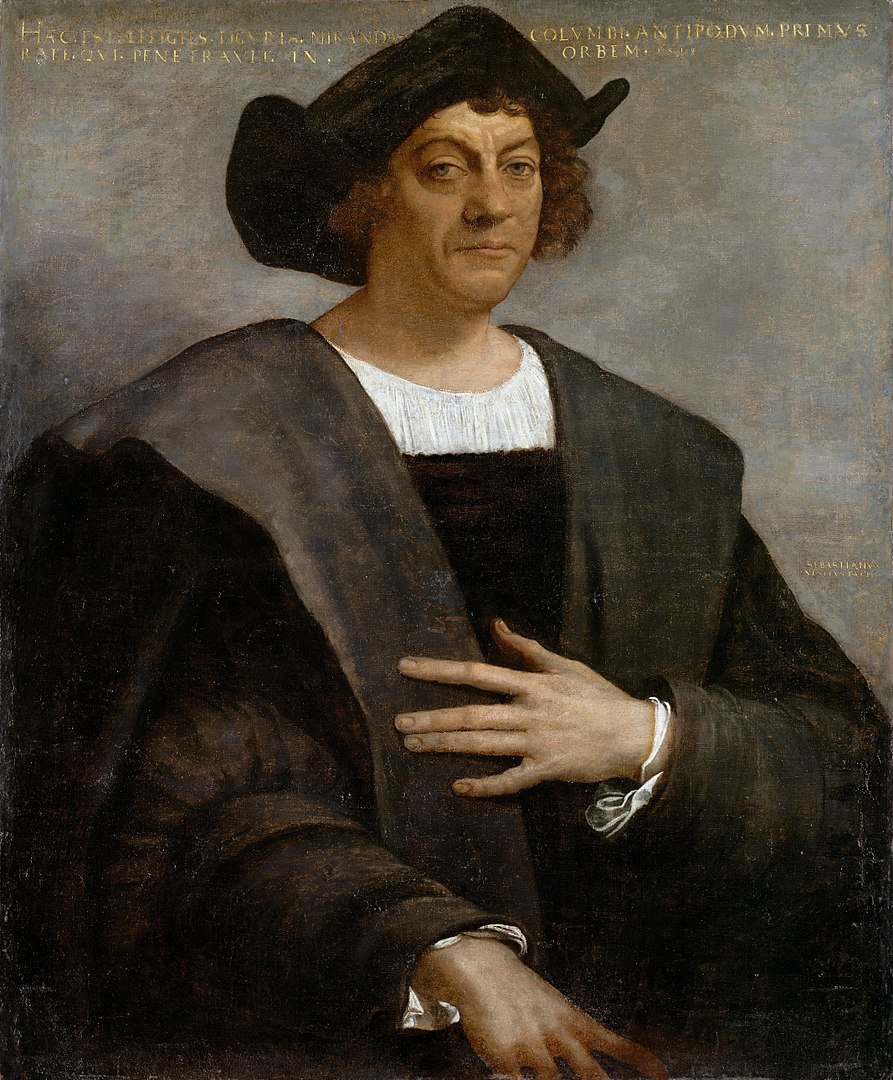
Portrait of Christopher Columbus – By Sebastiano del Piombo – This file was donated to Wikimedia Commons as part of a project by the Metropolitan Museum of Art. See the Image and Data Resources Open Access Policy, Public Domain, Link
European exploration: The Age of Discovery
It is evident to everyone reading this blog post who Christopher Columbus was. He was the explorer whose voyages brought a string of changes to the Americas. So, Christopher Columbus holds a crucial place in the history of the USA and the other American nations. But before we find out who Christopher Columbus was and how he set foot in the Americas, we have to first look at why he set sail.
Genghis Khan and the Silk Route
In the 13th century, the Mongols, led by Genghis Khan and his successors, began conquering the world. Their conquests, spanning from Japan in the East to Europe in the West, claimed the lives of millions of people. However, once their conquests were over, peace settled in.
During this period of peace, the Mongols re-established the silk route, which connected the eastern world with the western world. The silk route was also safe to travel because dacoits, burglars, and bandits were scared of being punished by the Mongols. So, they did not dare to attack the traders who traveled along the silk route. It was said that, during the Mongol times, a woman with a pot of gold can walk through the silk route safely. Moreover, the Mongols enhanced the silk road culturally by letting different religions coexist. So, several kingdoms from Europe, Africa, and Asia started trading through the silk route. The Europeans profited heavily by trading through the silk route.
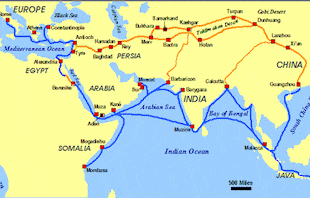
Map of the Silk Route – 120 AD to 1450 AD (Source)
Spices were one of the most expensive and in-demand products at that time. Europeans used spices to make food additives, preservatives, medicines, perfumes, cosmetic items, and religious rituals. So, spices became indispensable for medieval Europeans. Spices and many other goods mostly came from Asia and Africa through the silk route. Hence, many European nations depended on the silk route heavily for important goods and commodities.
Closure of the Silk Route
Around the middle of the 14th century, the Black Plague, the global pandemic of that time, hit Europe. It destroyed almost 30% – 60% of Europe’s population. Black Plague might have originated in China and traveled to Europe through the silk route.
A few years later, due to internal conflicts and partly due to the outbreak of the Black Plague, the Mongol Empire disintegrated. So, the silk route became rife with the disease as well as bandits and skirmishes. Thus, the silk route, which was once a secure passage to Asia, now became a dangerous route to take. So, travelers and traders who wanted to travel to Asia started taking longer, roundabout routes.
In the 15th century, the Byzantine Empire fell to the Ottoman Empire. When the Ottoman Empire came to power, it took control of all the trade routes and closed the silk route completely for Christian traders.
The need for finding alternative routes to Asia
European countries were in need of goods and commodities that the silk route had provided them until then.
Many of the currencies of the medieval ages were silver and gold coins. Europe had used many of these coins to pay for goods from the silk route. Since they were mostly importing goods, gold and silver always flowed out of Europe into the hands of traders of the silk route. As a result, Europe started to run out of its reserves of gold and silver.
Therefore, Europe was in dire need of goods the silk route had previously supplied as well as silver and gold. So, many countries started looking for alternative routes to reach Asia and Africa.
So, in the 15th century, the monarchs of many European countries started funding naval expeditions of exploration. These explorations had three main goals. Their first goal was to find new routes to reach Asia. Their second goal was to find reserves of gold and silver. Finally, they wanted to spread Christianity to new unexplored regions of the world. Thus, the centuries of exploration began.
Birth
Domenico Colombo was born in 1418. His family had been weaving clothes for two generations. So, his father took him as an apprentice and started teaching him about weaving when he was eleven years old. Thus, when he grew up, he became a wool weaver in Genoa, the capital of Liguria, in Northern Italy. But besides being a wool weaver, he was also a tavern keeper, cheesemaker, and wine dealer. Yet, even though he did multiple businesses, he wasn’t a rich man.
In 1455, he married Susanna Fontanarossa, a wealthy catholic girl. They had 5 children. The eldest of them, Christophoro Colombo (Christopher Columbus, in English), was born in 1451, sometime between August 25th and 31st. Even though the exact location of Christopher’s birth is unknown, he might have been born somewhere in or near Genoa, a seaport in Italy.
Early life
Very little is known about Columbus’ early life because it is not well-documented. Whatever we know of his parents and early life comes from his own testament of 1498 and the archived documents in Genoa and Savona.
Since Columbus was not born into a wealthy family, he did not get any formal education. So, only after becoming an adult, he taught himself to read and write.
When Columbus was a kid, he helped his father in his cheese stand. But since Genoa was a port city, it is not surprising that he grew up to become a navigator. As a kid, he might have seen ships arriving at the port and leaving it and fell in love with sailing. So, when he was just ten years old, he went to sea after finding work on a Portuguese merchant ship. For the next fifteen years, he remained at sea. While sailing, he also began an apprenticeship to become a business agent for the most influential families of Genoa. Meanwhile, his family moved to Savona, another port city in Liguria, because his father took over a tavern.
In 1476, while he was sailing along the Portuguese coast, pirates attacked his ship. So, his ship sank. But Columbus managed to survive by holding on to a wooden plank that washed ashore. He eventually reached Portugal’s port city Lisbon. He met his brother Bartolomeo there. Together they continued to work as traders for the influential families of Genoa.
Lisbon
Columbus was a very ambitious man. So, despite having no formal education, he taught himself to read and write. He then learned languages like Latin, Castilian, and Portuguese and read books on history, geography, and astronomy. He also joined the Prince Henry’s School of Navigation in Portugal, where he learned mathematics and navigation. Since his brother was working in the map-making business, he also learned cartography, the study of making and using maps.
In 1479, he married Filipa Perestrelo e Moniz, a woman from a wealthy Portuguese family. Her father was the governor of a Portuguese island called Porto Santo. One year after their marriage, Filipa gave birth to their son Diego. From 1477 to 1485, Columbus based himself in Lisbon and started trading. So, he made voyages to the coasts of West Africa and to present-day Ghana. When he returned from one of these voyages in 1484, he found that his wife had died. Their marriage had lasted for just six short years. After his wife’s death, Columbus took his son and left for Castile.
In 1487, he found a mistress for him in Castille. She was a 20-year-old-orphan and her name was Beatriz Enríquez de Arana. Together, they had a son called Fernando Columbus, who was born in 1488.
Spain and Portugal
The Iberian Peninsula
In the medieval ages, several kingdoms stood in the Iberian peninsula, where present-day Spain and Portugal are. Two of these kingdoms – the Kingdom of Castile and the Kingdom of Aragon – are worth mentioning. Like the other kingdoms of those times, their aim was to expand their kingdoms. So, they started merging with their neighbors through marriage and war. After these mergers, these kingdoms came to be known as Crowns since several kingdoms were under their control.
By the 15th century, a big part of the Iberian peninsula was controlled by the Crown of Castile and the Crown of Aragon. In 1469, after centuries of rivalry, these two Crowns united through the marriage of Ferdinand II of Aragon and Isabella I of Castile. But these two Crowns did not merge officially until 1516, when Charles V, the grandson of Ferdinand II and Isabella I, formally merged them to create the Kingdom of Spain.
The desire to reach Asia
In the fourteenth and fifteenth centuries, European countries tried to gain control of seaports and islands near North Africa. Once they controlled these seaports, they monopolized trade by levying taxes for ships passing through or landing at these ports. Portugal was one of the first European countries to do this.
For centuries, slave and gold trades between West Africa and the European countries to the north of the Mediterranean Sea were controlled by the Muslim rulers of Africa. Prince Henry, the Navigator, of Portugal wanted to bypass these rulers and trade directly with West Africa by sea. So, he wanted to see how far the control of these Muslim rulers of Africa stretched. Moreover, he wanted to find the Indies – which is how the Europeans called the lands of India, China, and Japan, from where the spices came. He also wanted to find new lands to spread Christianity. So, in the early 15th century, he funded sea expeditions along the West African coast.
Until the 15th century, Europeans had only navigated up to the port of Cape Chaunar in southern Morocco. They believed that if they traveled beyond this point, they might be killed by sea monsters or fall down the edge of the world.
In the early 15th century, the Portuguese invented a new type of sailing ship called the caravel. It could travel faster than other ships. In addition to that, the sailors could also easily maneuver it.
In the fifteenth century, navigating using compasses became more advanced and widespread. So, Europeans did not have to just rely on the stars to steer their ships anymore.
Therefore, all these technological advancements, combined with the sponsors from Prince Henry of Portugal, inspired many people to abandon their fears and go to sea.
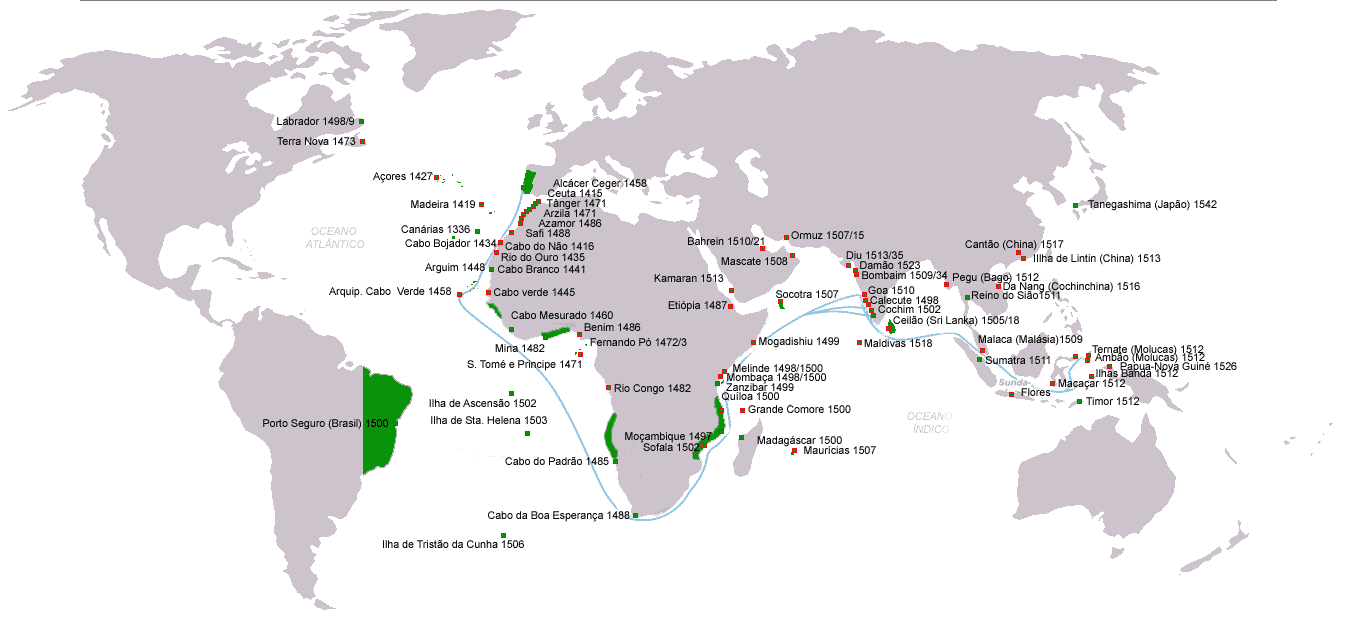
Portuguese Discoveries 1415 AD to 1543 AD – By Descobrimentos_e_explorações_portugueses.png: *Portuguese_discoveries_and_explorations.png: *Portuguese_Empire_map.jpg: Toklederivative work: Uxbona (talk) – Descobrimentos_e_explorações_portugueses.png, CC BY-SA 3.0, Link
God, Gold, and Glory
During Columbus’ time, people were inspired by God, Gold, and Glory, to take up exploration. That is, they wanted to convert the barbarians in unknown lands to Christianity, wanted to take the riches from these unknown lands, and wanted to become famous by finding sea routes to these unknown lands. Columbus wasn’t any different. He wanted all of these too. So, he decided to find a sea route to the Indies.
Columbus wanted to get rich by finding a faster route to the spice islands of the Indies. During Columbus’ time, spices were so valuable. So, procuring them through a quicker route would make the spice trade more profitable.
Columbus’ proposal
European explorers sailing along the west coast of Africa hadn’t even reached the southern tip of Africa yet. They still had to sail around the southern tip of Africa into the Indian ocean to reach Asia. But Europeans at that time didn’t know that. They did not have a precise map of the world. They did not even know where Asia was.
Most people at that time knew that the earth was spherical. So, they knew that it might also be possible to reach the Indies by sailing west into the Atlantic ocean instead of sailing east along the African coast. However, most people believed that sailing west to reach the Indies would be a much farther route than sailing East. But Columbus believed that the world was much smaller than people thought it was. So, he believed that sailing West would be faster than sailing east along the African coast.
In 1481, Columbus received a map of the Atlantic Ocean from the Florentine astronomer Paolo dal Pozzo Toscanelli. Like Columbus, Toscanelli also believed that a Western sea route to Asia was possible. He had met the king of Portugal in 1470 to explain his plans but was rejected. In the map that Toscanelli sent Columbus, the entire continent of America was left out because, back then, nobody knew that such a continent existed. This map solidified Columbus’ belief that a western sea route to Asia would be quicker.
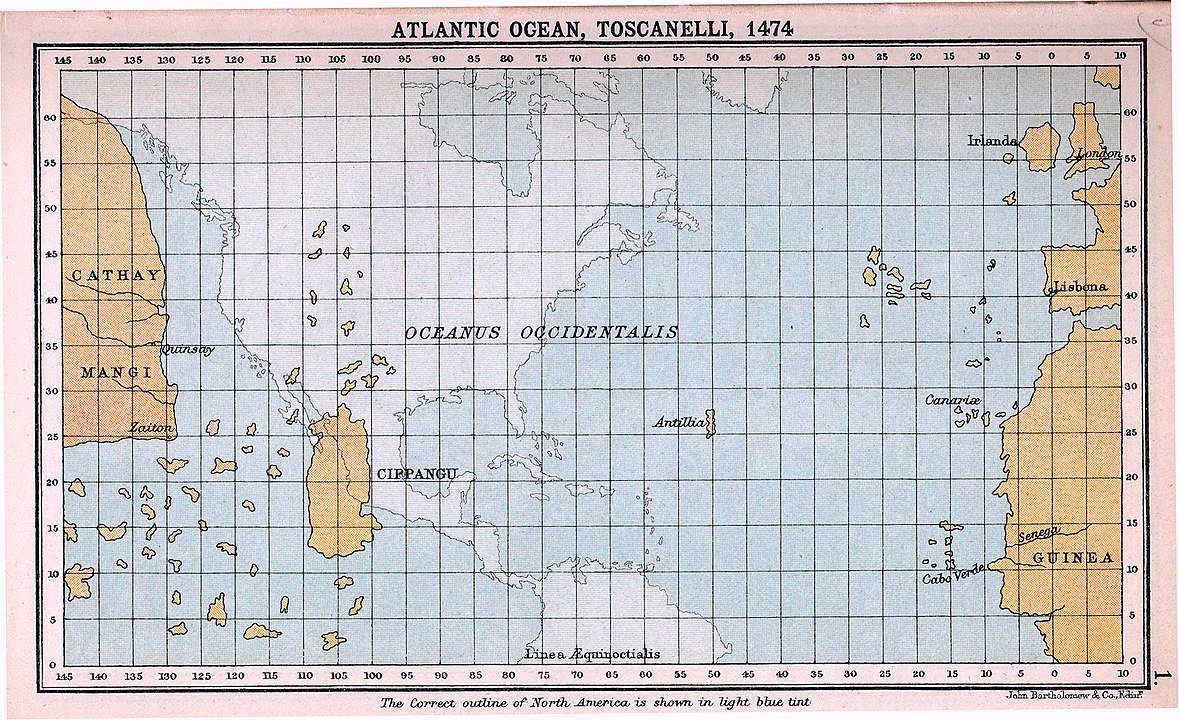
Toscanelli’s map of the Atlantic Ocean (shown superimposed on a modern map) – By Bartholomew, J. G. – A literary and historical atlas of America, by Bartholomew, J. G. [1], Link
Proposing his plans to the French king
Therefore, in 1484, Columbus met the king of Portugal, John II, to explain his plans. After listening to his proposal, the king asked his experts for their opinion. The king’s experts figured out correctly (we know that now) that Columbus had wrongly estimated the distance to the Indies. If one sailed West, the actual distance to the Indies should actually be three times more than Columbus’ estimate. Heeding the experts’ opinion, the king refused to sponsor Columbus’ voyage.
Proposing his plans to the Spanish crown
So, in 1486, Christopher Columbus met Queen Isabella I of Castile. At that time, Isabella was ruling most of the Iberian peninsula along with her husband, King Ferdinand II of Aragon. Columbus proposed his plan to reach Asia by sailing West. When Isabella I consulted her experts regarding Columbus’ plans, they too, like the experts of King John II, were of the belief that Columbus had severely underestimated the distance to the Indies. They believed that sponsoring Columbus would be a big mistake.
In 1478, Castile fought a naval battle against Portugal for the domination of trade with Guinea, a West African country. After winning this battle, Portugal obtained the sovereignty of several West African territories. With this victory, Portugal also started monopolizing the sea routes along the West African coast. So, to bypass Portugal’s monopoly over the West African sea routes, Queen Isabella wanted to keep Columbus’ proposal of sailing West to reach the Indies as a backup option. Therefore, she didn’t want him to take his ideas elsewhere. But she couldn’t fund him immediately because, at that time, Castile was fighting the Granada War.
Castile postpones funding for Columbus
The Emirate of Granada was a Muslim nation in the southern part of the Iberian peninsula. For 250 years, these Muslims had been paying tribute to the Crown of Castile to prevent it from attacking them. They even sent troops to aid Castile in their conquests. However, after Castile and Aragon united in 1469, Castile set its sight on Granada. So, in 1482, it waged the Granada War, a series of military campaigns against the Emirate Granada.
Since Castile was fighting the Granada war when Columbus proposed his idea, Isabella couldn’t fund his voyage. At the same time, she didn’t want him to take his ideas elsewhere. So, she sent Columbus, the annual salary of a sailor for the next six years. In 1489, Isabella also ordered the cities under her control to provide Columbus with free accommodation and food.
Christopher Columbus’ First Voyage
After the Emirate of Granada was conquered in 1492, king Ferdinand and Queen Isabella promised to fund Columbus’ voyages. They promised to make him an admiral of the ocean if he succeeded. They also promised to make him the Viceroy and Governor of all the areas he would discover for Spain. He could keep 10% of the gold, silver, precious stones, spices, and other objects he could acquire from the new territory. He was also promised revenues and profits from the new ventures that would be established in these new lands.
So, in 1492, after making such a lucrative deal with the Spanish monarchy, Columbus set sail westward. He took three ships with him. These ships were named Santa Maria, Pinta, and Nina. After restocking his ships in the Canary Islands near Africa, Columbus continued his voyage.

After a five-week voyage, they reached the Bahamas, the group of islands located a few hundred kilometers east of Florida, USA. Thus, on October 12th, 1492, Columbus had become the first European to set foot in the Americas.
During his first voyage, Columbus met many native people. Columbus called the native, indigenous people Indians because he believed that he had reached the Indies. He saw that these people were sturdy and well-built. They could repeat what he told them, indicating that they could learn languages easily. Yet, they were not technologically advanced. They were either naked or wore minimal dresses, covering only their genitals. Moreover, they used only primitive weapons. So, he came to the conclusion that they could be easily conquered and enslaved. He wrote his findings in a journal he maintained.
The Carbis and the Arawaks
The early Spanish explorers classified the native people in the Caribbean into two types – The Caribs and The Arawaks. The Caribs were hostile cannibals who attacked the Spanish when they tried to get near them. On the other hand, the Arawaks were friendly people who were willing to help the Spanish. Some of the Arawaks wore golden ornaments. Looking at their gold instruments, Columbus believed that the island would have more gold. So, he kidnapped some of them and forced them to show the source of their gold.
After spending some time in the Bahamas, Columbus set sail once again and reached Cuba. Then he went to Hispaniola, an island in the Caribbean. There, Santa Maria, one of his ships got damaged. So, to make Columbus happy, the Arawaks gave him some gold. When they noticed that Columbus became happy at the sight of gold, they gave him more gold. Columbus noticed that most Arawaks had nothing to do all day and were simply idling away their time. They wore golden ornaments and were willing to give them away to make him happy.
La Navidad, the first European settlement in the Americas
Columbus was astonished at the Arawaks, who had no care in the world, had no desire for worldly possessions, and were willing to help others so gladly. So, with the permission of a local chief of Arawaks, Columbus established a settlement in Hispaniola. Columbus and his men constructed a small temporary fort in this settlement using the materials from Santa Maria. This settlement, called La Navidad, became the first European colony in the Americas. The men who sailed onboard the Santa Maria stayed back in La Navidad to collect gold. Meanwhile, Columbus and the remaining men sailed back to Spain. They took the gold the native people had given them and kidnapped some native people to be shown to the Spanish monarchs.
While returning to Spain, Columbus wrote a letter detailing his discovery and requesting to sponsor a second expedition. He wrote that he had found islands that contained riches, and probably, China was very close to these islands. He described the Arawaks and the Caribs and mentioned the possibility of bringing Christianity and civilizing these barbarians. After he reached Lisbon, Portugal, Columbus sent the letter to the Spanish monarchs.
The year was 1493. The news of Columbus’ discovery spread through Europe like wildfire. Vasco da Gama would reach India only five years later, in 1498. So, Europeans at that time believed that Columbus had actually discovered the Indies, which is how Asia was called then.
Second voyage
Columbus’ discoveries were able to convince the Spanish monarchs to sponsor his expeditions for a second time. So, Columbus set sail on his second voyage in September 1943. This time, he took 17 ships and 1200 men with him, including farmers, soldiers, and priests.
After Columbus left for Spain, the Spanish people in the settlement he created started attacking the native people searching for gold and women. So, some native people thought that Spanish settlers were beasts from the underworld who came to eat their flesh. So, they attacked La Navidad, the settlement that Columbus had established in Hispaniola, and killed the 39 people there. Therefore, when he reached La Navidad, Columbus found the settlement empty. So, he established a second colony.
The search for gold begins
Columbus and the Spanish settlers started building forts in Hispaniola. Then, they started demanding the Arawaks to hand over the gold they had. The Arawaks, who didn’t value material possessions, gave them all the gold they had. But even after the Arawaks gave the Spanish all the gold they had, Columbus was not satisfied.
Columbus believed that Hispaniola had reserves of gold and the locals knew where they were located. So, Columbus issued a decree forcing all Arawaks aged fourteen years or more to bring a certain amount of gold dust every three months. Wherever gold was unavailable, each person had to give 25 pounds of cotton instead. When anyone failed to collect enough gold or cotton, Columbus punished them by cutting off their limbs or killing them. Each native tribal chief was made responsible for the collection of gold from his tribe members.
Torturing native people to find gold
Unfortunately, Hispaniola did not have such vast amounts of gold reserves. The gold that the Arawaks had given the Spanish settlers initially was the result of collecting gold for many years. So, even after searching continually for several hours every day, the Arawaks could not meet their tribute requirements. Many Arawaks were also tortured, beaten, raped, and killed when they failed to disclose the location of imagined gold reserves. Therefore, many of them tried to escape from the Spanish by fleeing into the mountains. But those who fled were chased down using hunting dogs that were trained to kill. In short, the lives of Arawaks were turned upside down after the arrival of Columbus.
Christopher Columbus went to the Americas looking for wealth and fame. But there was one other reason why he went there. He truly believed that Queen Isabella and King Ferdinand were messengers of God. He believed that God assigned him the mission of helping them find the kingdom of wealth and civilize the ignorant masses. To him, Arawaks were the uncivilized, ignorant masses whom he must civilize. And the way he would civilize them was by enslaving them, give them dresses, and converting them to Christianity. So, he took 500 Arawaks as slaves to Spain while returning from his second voyage. Almost 40% of them died during the voyage.
Third voyage
Christopher Columbus began his third voyage in 1498 with six ships. This time, he sailed further and reached Venezuela in South America. He recognized that this was not a small island, and this should be a bigger country. He sailed around for some time, reaching the islands near South America, and returned to Hispaniola.
Columbus’ rule of tyranny as Hispaniola’s governor
When Columbus returned to Hispaniola, he found his colonists and the natives revolting against his rule. Columbus hanged the Spanish colonists who opposed him. He killed the natives who opposed him by cutting off their body parts. Then, he paraded their bodies through the streets to discourage further rebellion.
Columbus also awarded severe punishments for meager crimes. Once, he cut off the ears and nose of a man and sold him into slavery for stealing corn. He also paraded women naked through the streets and sold them into slavery. So, unable to take his rule anymore, the natives rebelled against him. So, in 1499, Columbus ended the system of collecting tribute through tribal chiefs and implemented the system of Encomienda.
According to this system, instead of controlling the entire Hispaniola as its governor, Columbus split the land and the native people among individual Spanish settlers. The natives hoped that, by doing so, their exploitation would cease to exist. However, their new masters, the individual Spanish settlers, exploited them too. They cut off their limbs as punishment and sold them off as slaves.
Decimation of the native population
So, thousands of native Arawaks killed themselves instead of serving under their masters. Many of them burned their own crops hoping that the Spanish settlers would die of starvation even though it meant that they themselves would die too. Many more died due to overwork and diseases.
Therefore the population of the native people reduced tremendously within a century. For example, there were at least a hundred thousand Arawaks in 1492. But by 1542, just fifty years after the arrival of Columbus, only 200 of them were left. The same was the case for other native people as well.
The Europeans had brought new diseases like smallpox, influenza, and malaria. The Europeans, who had already seen these diseases, had developed better immunity to them. However, these diseases were new for the natives in the new world. Moreover, they were forced to work on a massive scale in gold and silver mines as slaves. Under these working conditions, the diseases spread quickly and violently. So, many natives died due to diseases too. Even if they developed immunity for one disease, they were killed by another disease. Sometimes, the outbreak of these diseases came centuries apart. So, the native population, which fell tremendously due to the Spanish arrival, was never able to recover.
Columbus’ rule of tyranny comes to an end
Thus, Columbus’ reign as a governor greatly affected America and its native people. Even his own Spanish followers were not happy with him. By 1499, the Spanish monarchs came to know of Columbus’ tyrannic rule, including his method of executing without trial. So, in 1500, they stripped him of his position, arrested him, and brought him back to Spain. But he was released after spending just six weeks in prison. Even his wealth was restored.
Fourth and final voyage
Christopher Columbus was somehow able to convince the Spanish monarchs to fund his voyage once more. However, he wouldn’t be the governor anymore. So, in 1502, he set sail with the new governor. This time, he reached Central America. However, his fourth voyage was not as much eventful as his other voyages because the new governor detested Columbus. So, two years later, he returned to Spain.
Death
Christopher Columbus died on May 20th, 1506, aged 54, probably due to severe Reactive Arthritis, a pain in the joints caused due to an infection in some other part of the body. The infection might have been caused due to food poisoning during his voyage. Columbus died believing that he had found a shorter route to Asia.
Facts about Christopher Columbus
- Christopher Columbus’ voyages led to the exchange of trade, ideas, culture, flora, and fauna between Europe and the Americas. They led to globalization and became a turning point in history. But they also started the colonization of the Americas and exploitation of the native people there. They also started the slave trade between Europe and the Americas.
- Christopher Columbus landed in the Americas on October 12th, 1492. Therefore, many countries in the North and South America celebrate October 12th to remind themselves of their common heritage. The USA celebrates the day as Columbus Day.
- Christopher Columbus wasn’t the first European to set foot in the Americas. The Viking explorer Leif Erikson had already sailed to Canada in the 11th century.
What to read next?
Did this biography of Christopher Columbus help you understand the history of Christopher Columbus and how he set foot on the Americas? Then you might like the following biographies too:
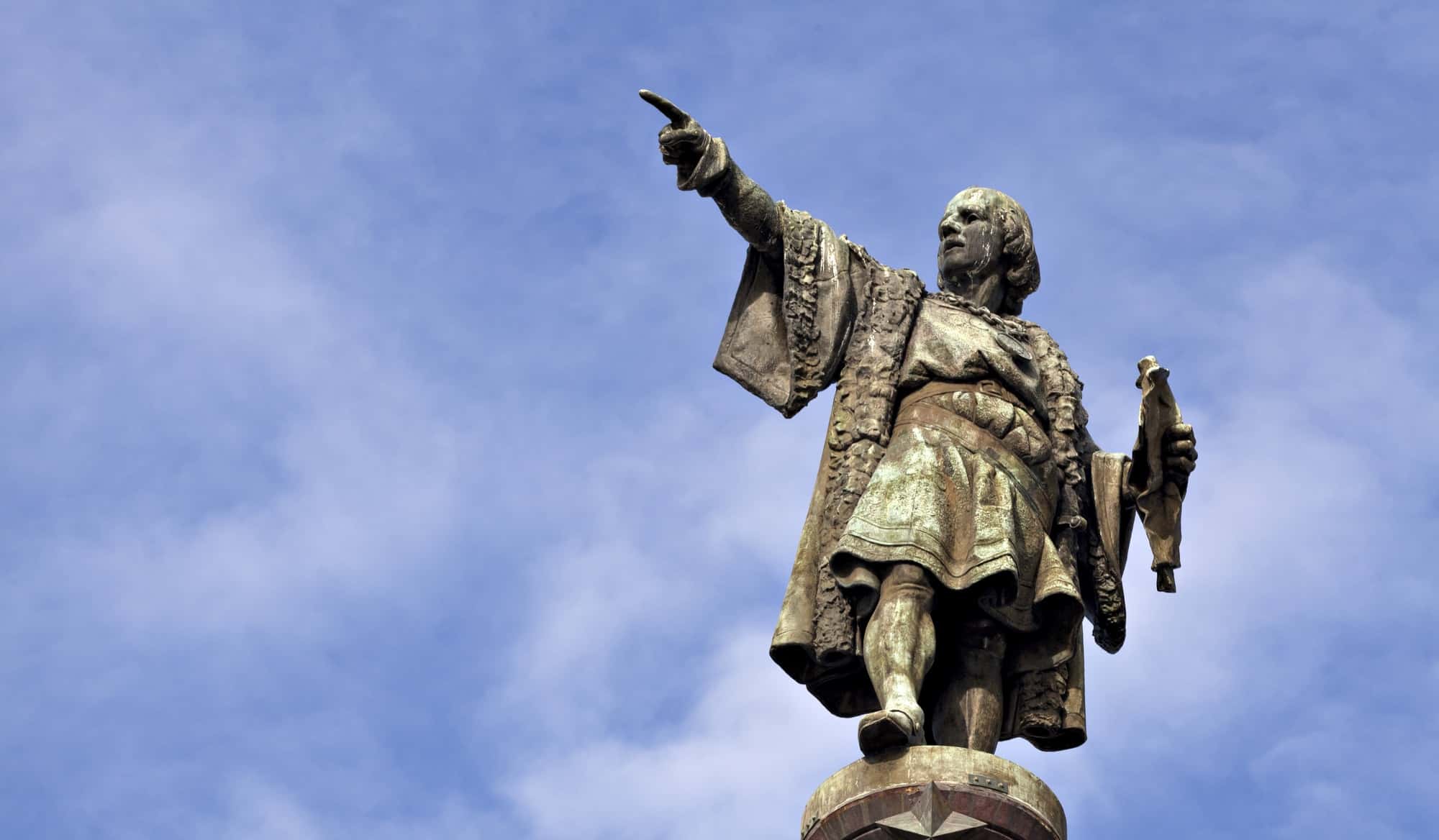
Leave a Reply